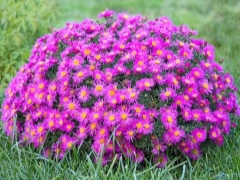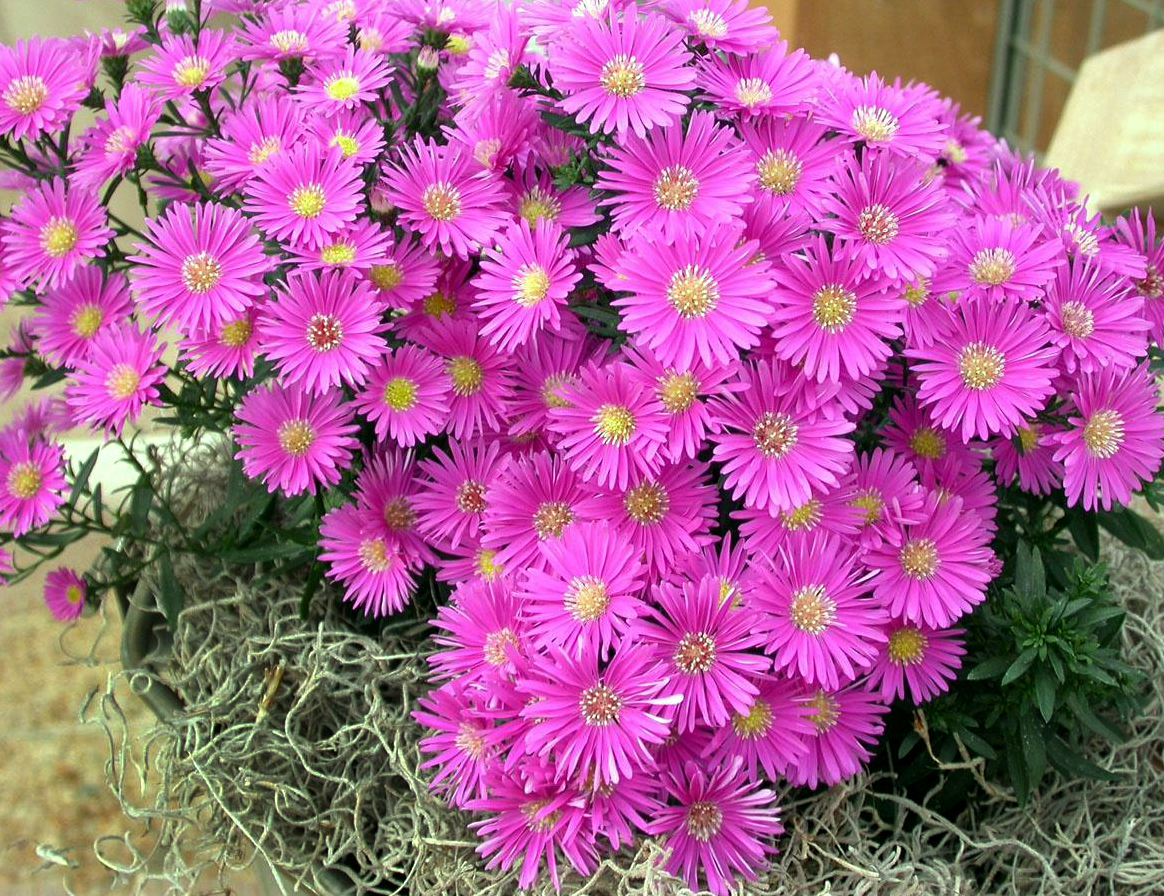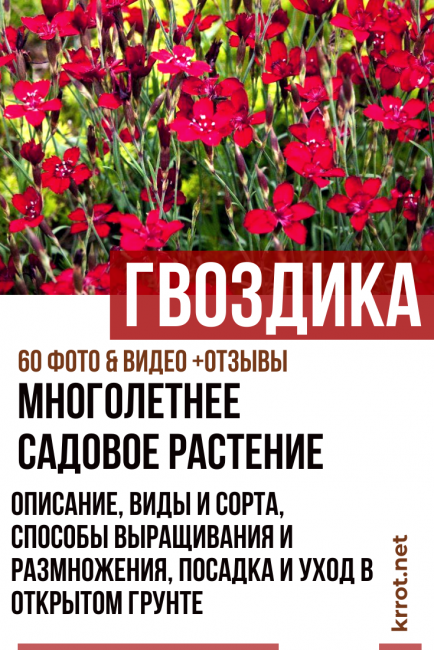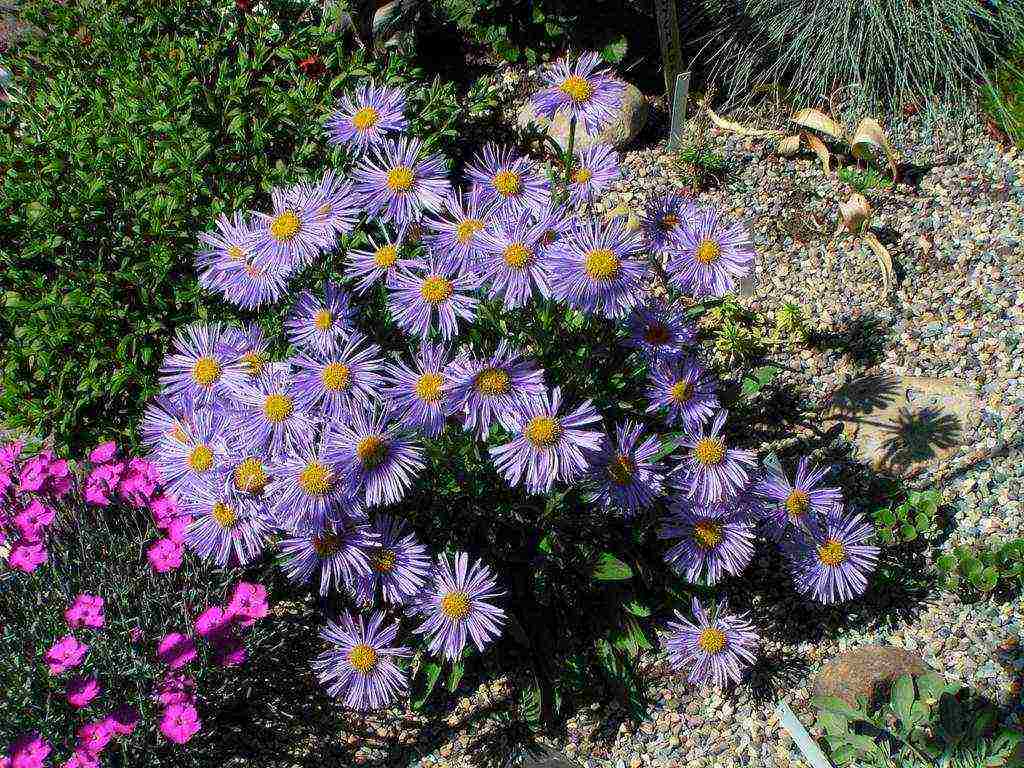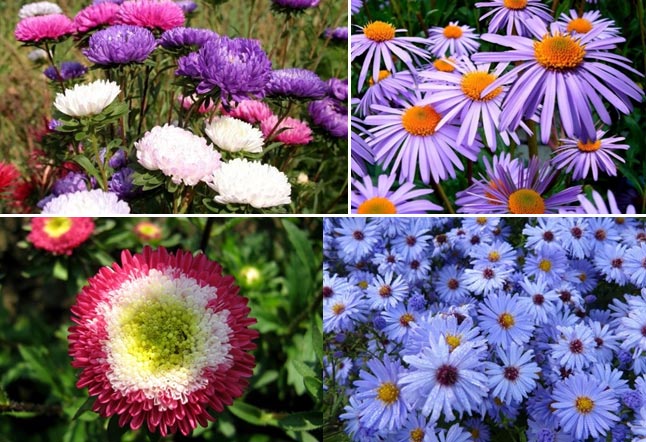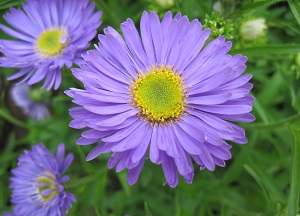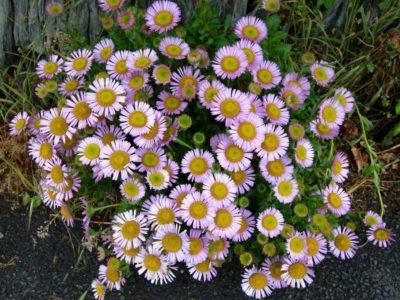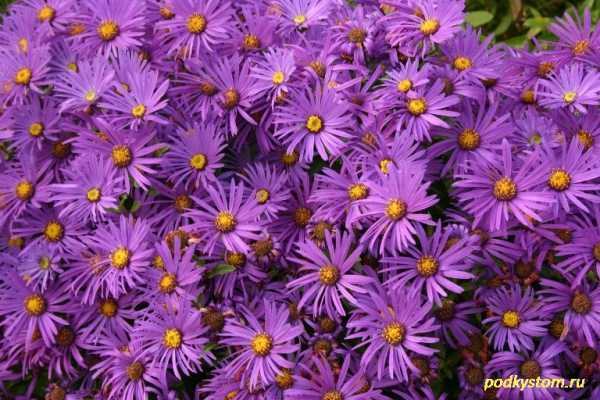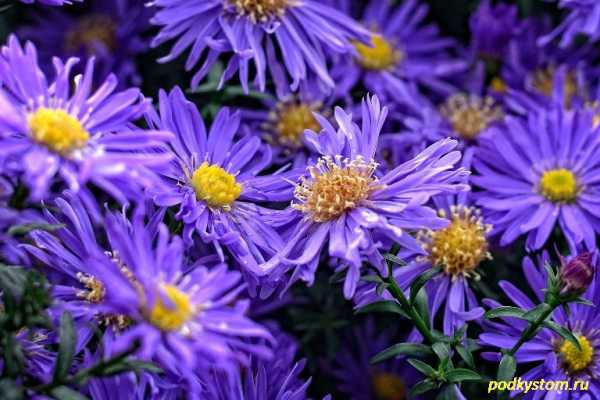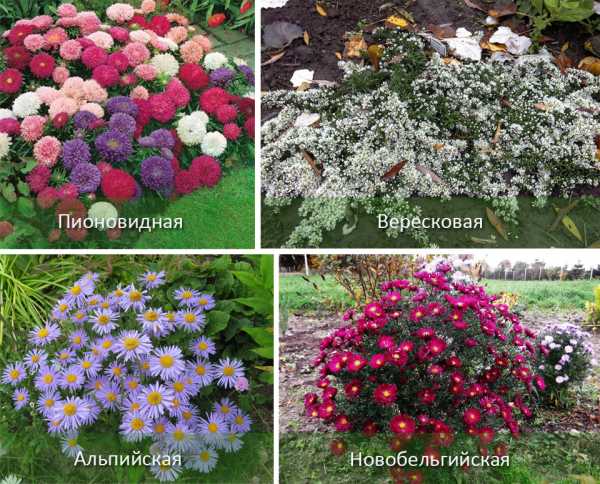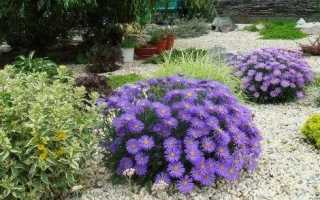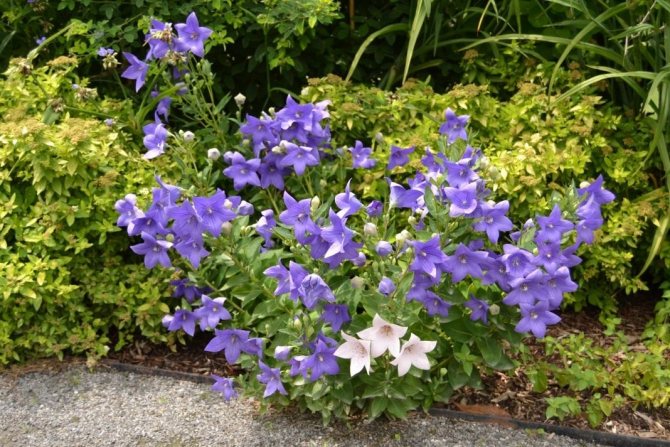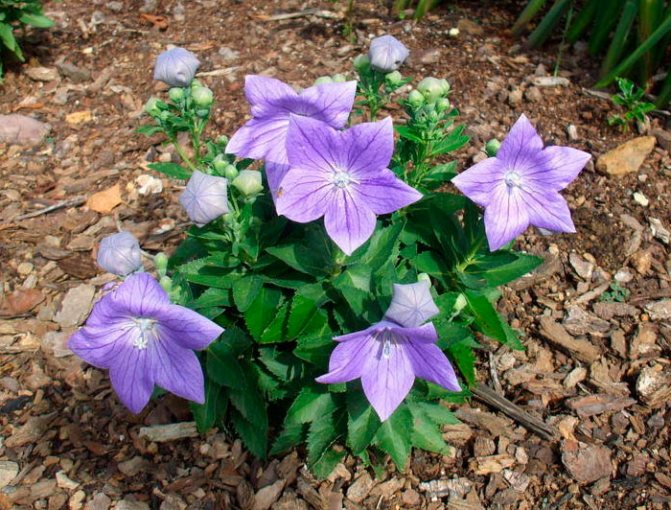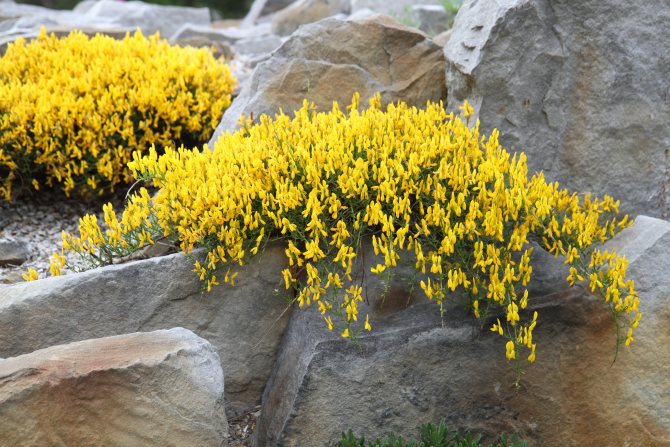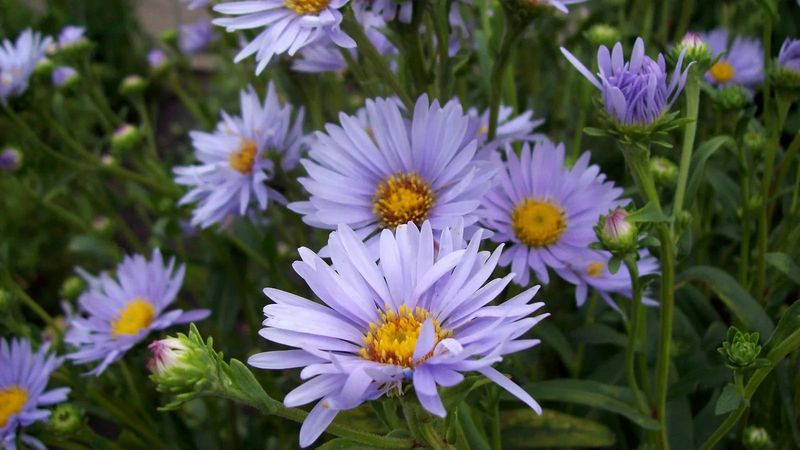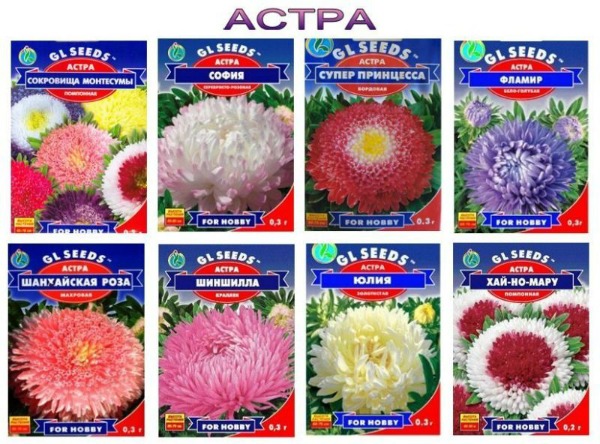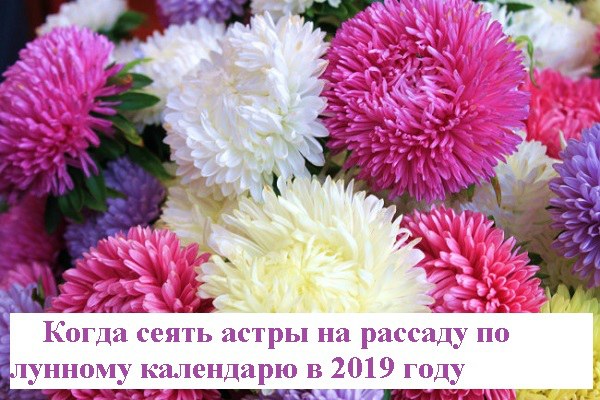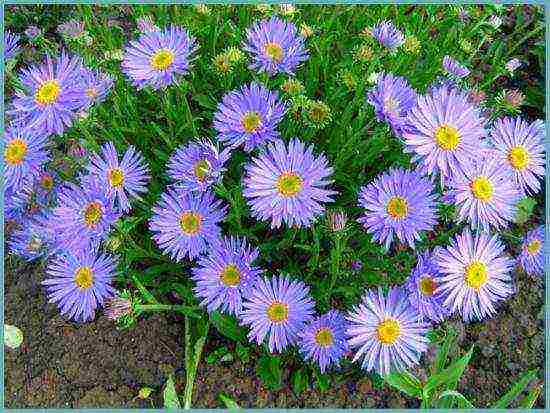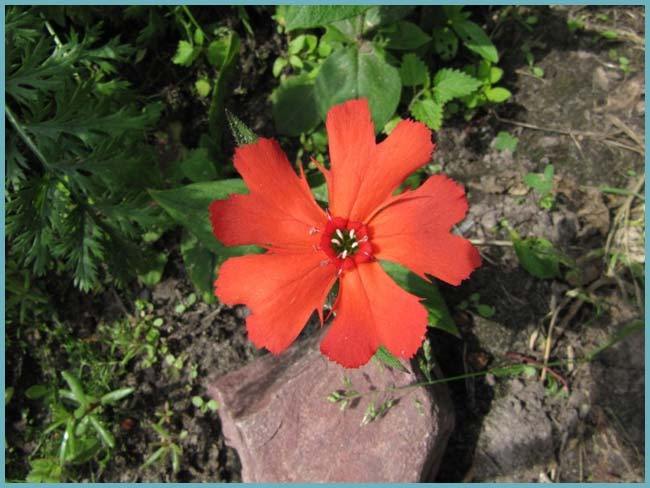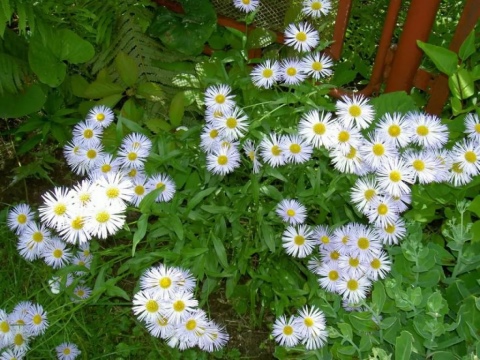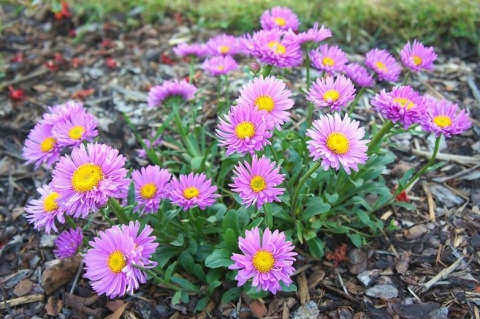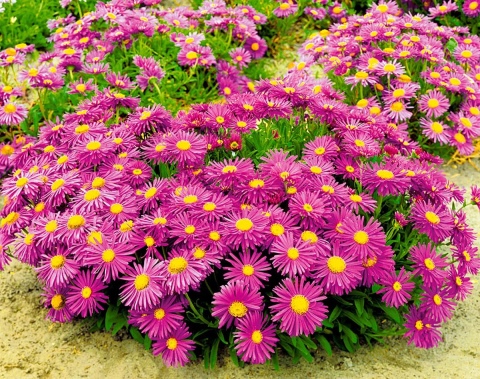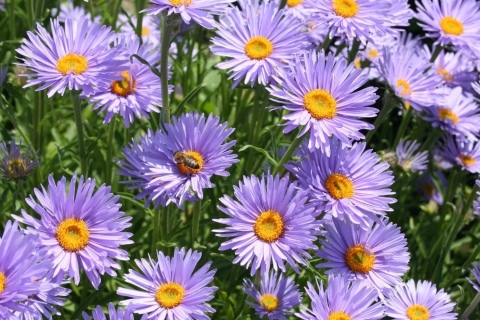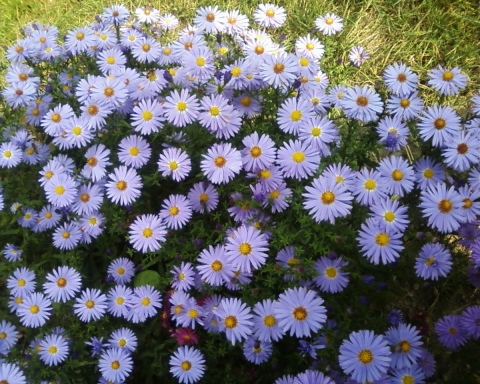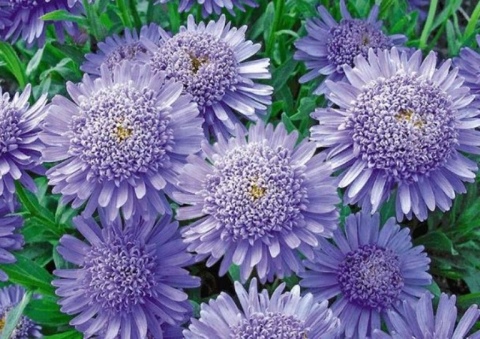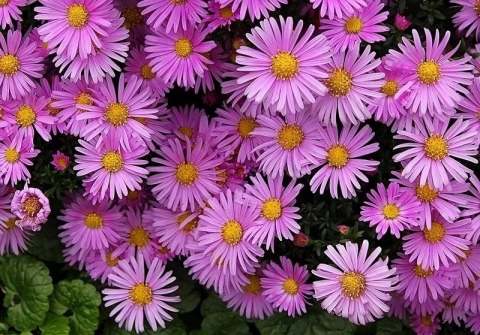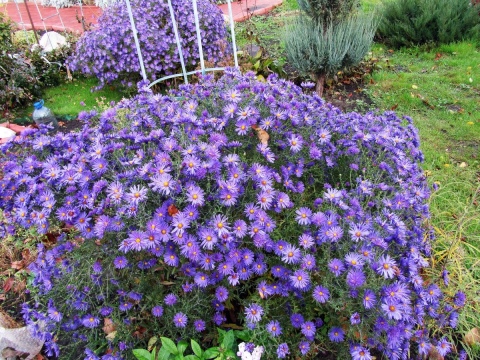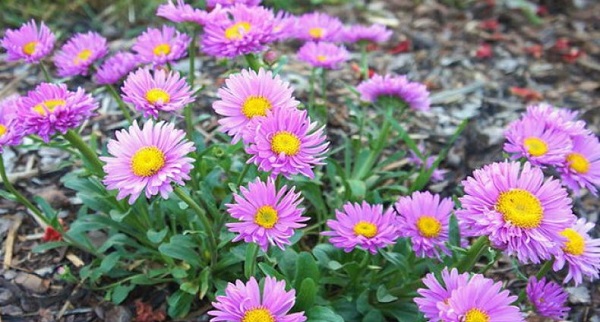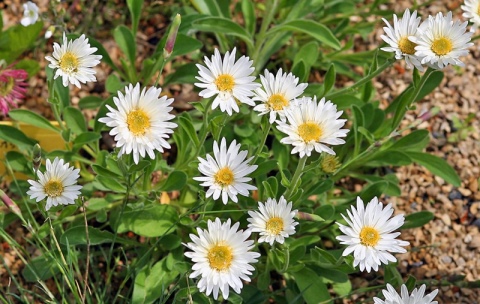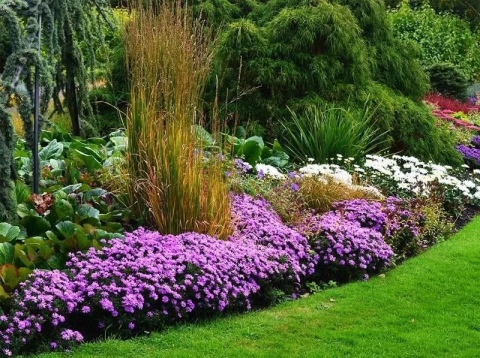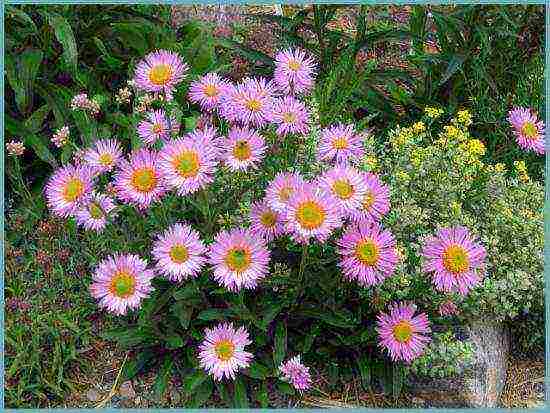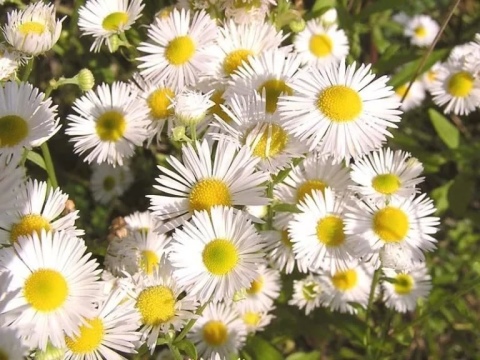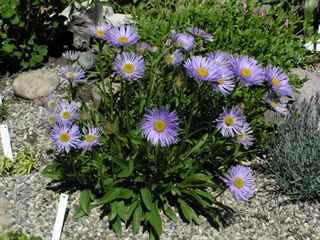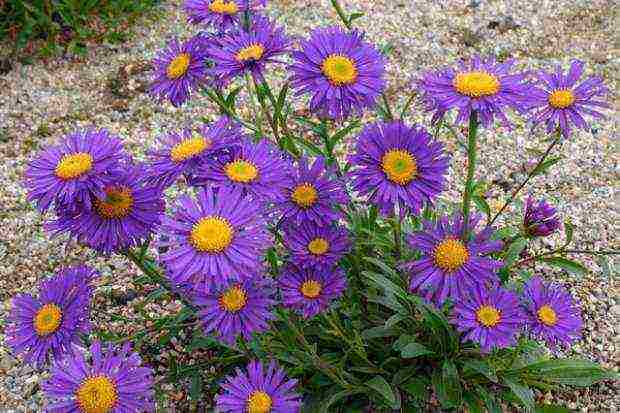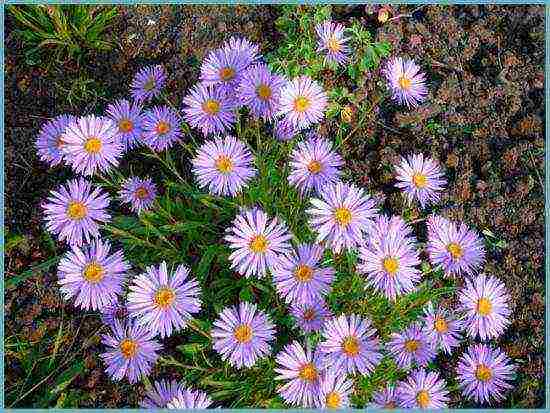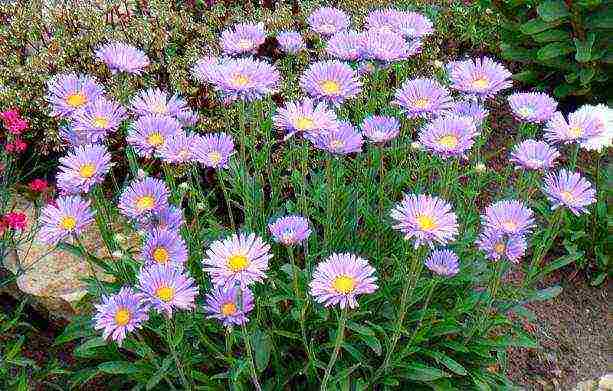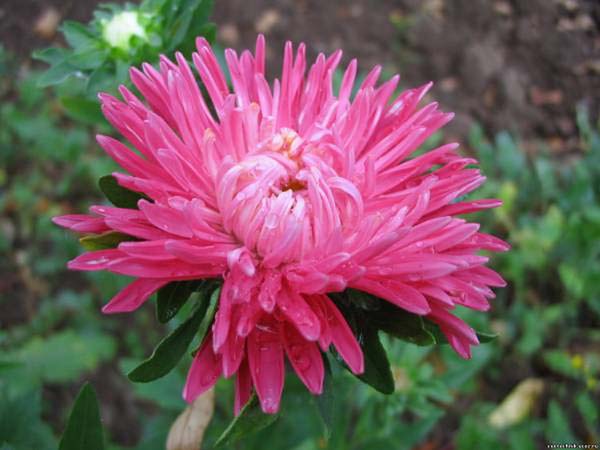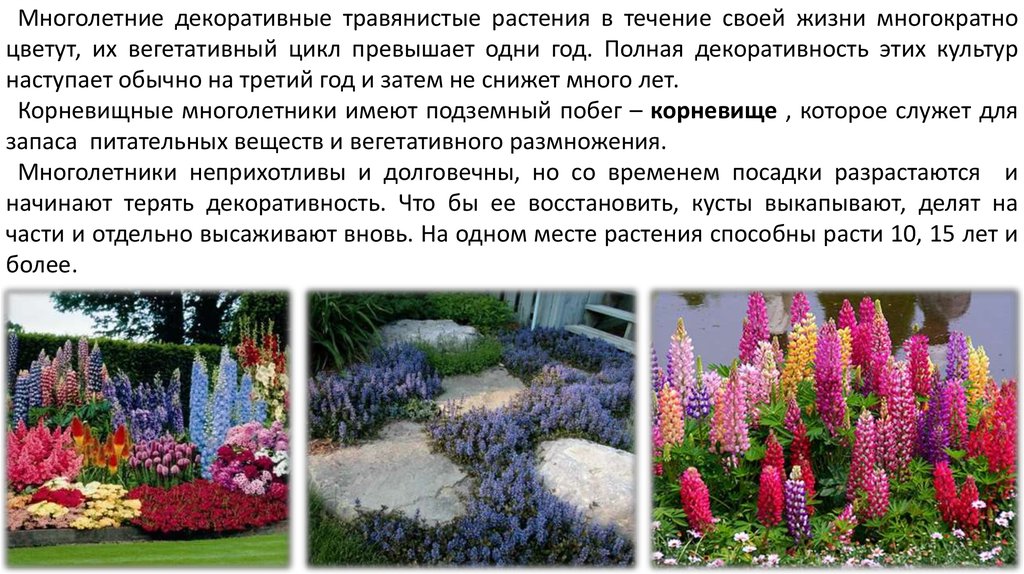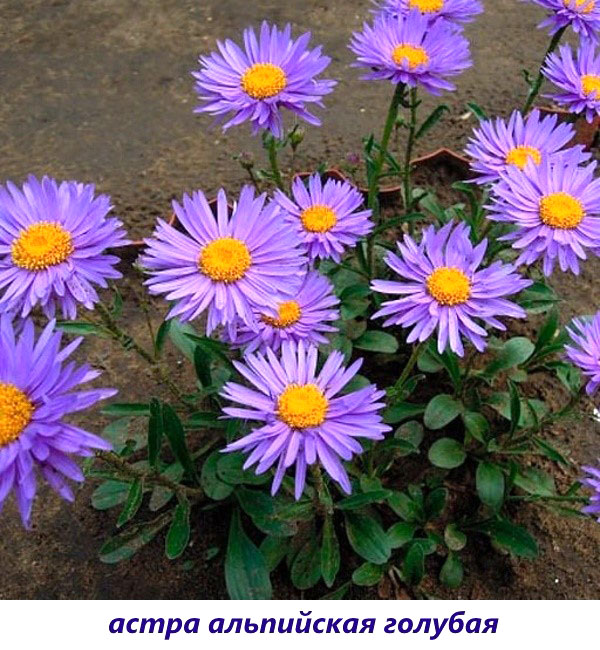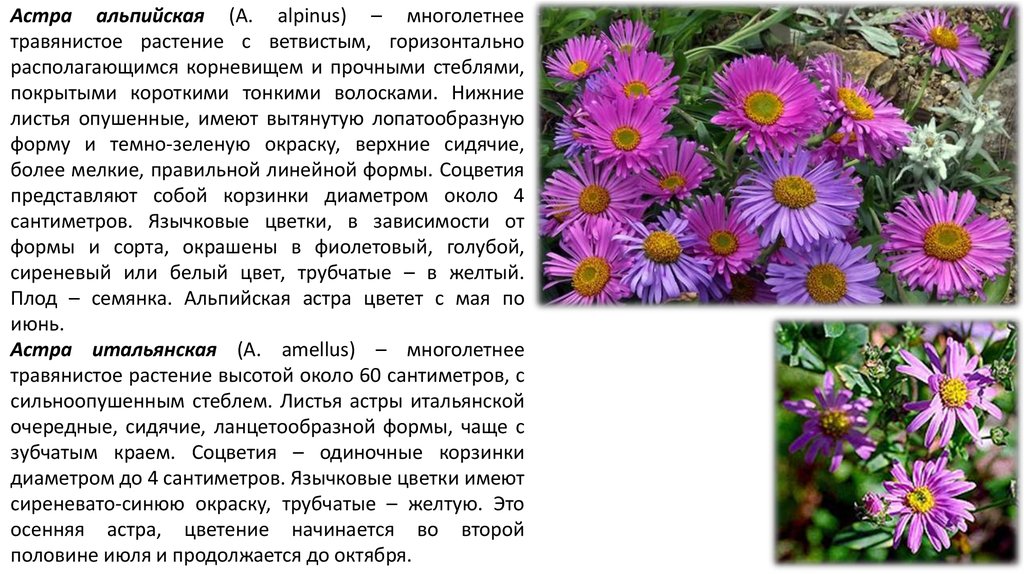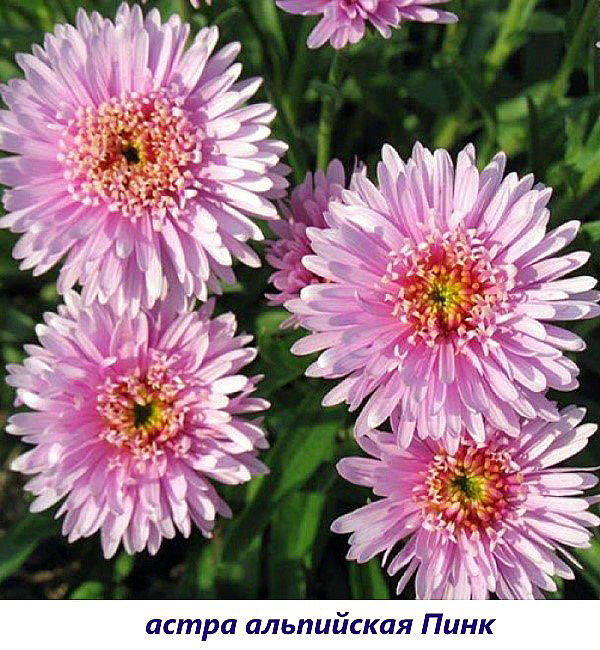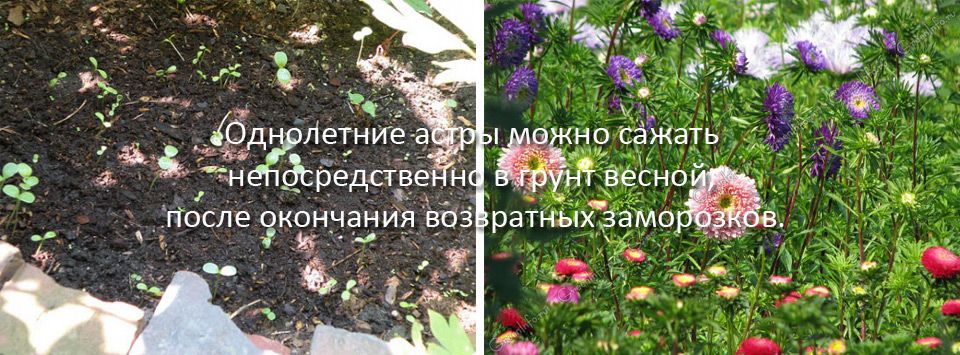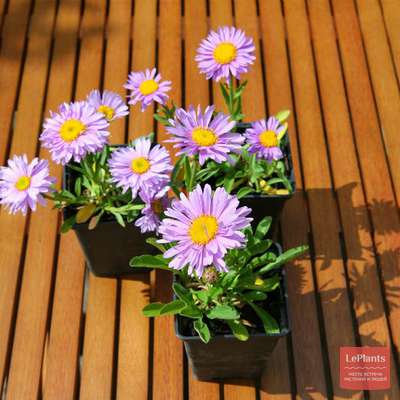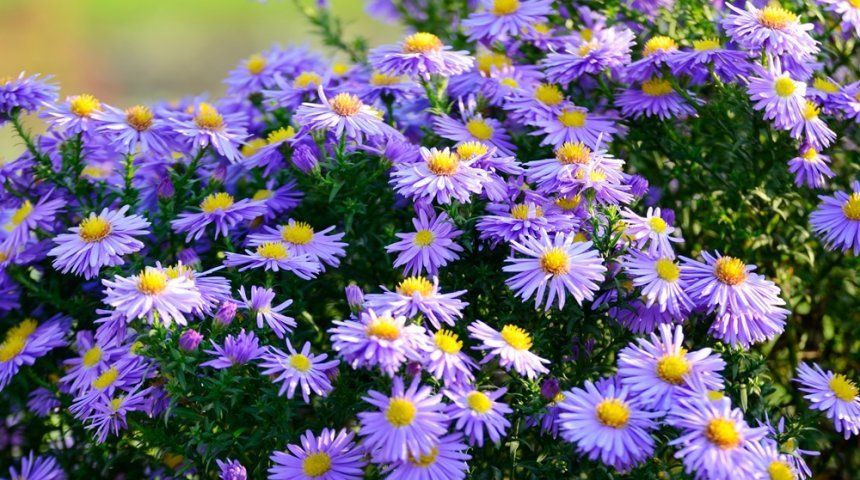General description, varieties, photo
The plant is classified as Compositae and has about 600 species. Due to the fact that perennial asters are distinguished by late flowering, they are often called winter asters or octobrines. Plants, depending on the species, can grow as a separate flower or bush, and grow up to two meters. Their flowering begins in the first days of autumn and attracts the eye with its various colors. Aster inflorescences can have shades from white to purple.
Perennial asters differ in terms of flowering time and appearance. Alpine asters bloom in June, and in August they are replaced by lush perennials of Italian varieties. In early autumn, shrub asters decorate the garden with flowers of various shades.
Types of perennial asters
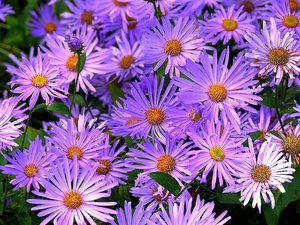 Alpine aster - photo. A low-growing plant, which is native to the Alps, reaches a height of only 30 cm. Its flowers resemble chamomile in shape and have a diameter of 4-6 cm. They are located on one stem. The flowers are formed from a yellow double center and tubular petals of pink, purple or white. Alpine aster begins to bloom in early summer. Its bushes bloom profusely throughout the month. The plant looks very beautiful on alpine slides or in group plantings with low-growing crops. The most popular varieties:
Alpine aster - photo. A low-growing plant, which is native to the Alps, reaches a height of only 30 cm. Its flowers resemble chamomile in shape and have a diameter of 4-6 cm. They are located on one stem. The flowers are formed from a yellow double center and tubular petals of pink, purple or white. Alpine aster begins to bloom in early summer. Its bushes bloom profusely throughout the month. The plant looks very beautiful on alpine slides or in group plantings with low-growing crops. The most popular varieties:
- The Wargrave variety is a plant up to 30 cm high. Pink flowers with a yellow center bloom in May and bloom for a month.
- Glory has a hot-yellow center and blue-blue petals. Flowers with a diameter of 4 cm are formed on shoots 25 cm high.
- The Helen Beauty variety is a perennial with erect stems up to 15 cm high. Its root rosette of leaves is small, and its semi-double bright purple flowers are of average size. The variety looks great in combination with Chinese carnation, creeping gypsophila and Iberis.
- Dark Beauty variety is distinguished by medium-sized blue-violet flowers. They bloom in July-August and look great on the front border in borders and rockeries.
- The Galiaf variety is a perennial with a good root rosette, elongated leaves, leafy stems and light purple flowers. Blooming for about 30 days, the plant is used to decorate rockeries, alpine slides and borders.
Shrub aster. The native land of the plant is North America. The varieties of this species are distinguished by strongly leafy stems with a height of 20 to 60 cm. Of all types of autumn perennials, shrub aster blooms first. Its most popular varieties include:
- The Blue Bird variety is a dwarf plant 25 cm high. The reed-shaped flowers have a pale blue color with a lilac tint.
- Alba flora foam grows up to 40 cm in height and has petals of various shapes. Its tubular petals are yellow, and the reed petals are snow-white in color.
New England aster. The plant reaches a height of two meters and blooms profusely with white, red, pink, blue or dark purple flowers. Inflorescences with a diameter of 4 cm bloom in early autumn. The species is suitable for making bouquets. Cut flowers can stand in water for up to two weeks.
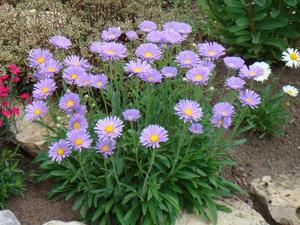
New Belgian aster. A perennial plant with a height of 35 cm to one and a half meters is distinguished by not very large flowers of light purple, lilac, pink, burgundy or white. Depending on the variety, Novobelgiskaya aster can be dwarf, medium-sized or tall.
Italian aster. The plant consists of bushes, the height of which can be up to 70 cm.Differs in corymbose inflorescences - baskets, which are collected from flowers of pink, lilac, yellow or dark blue. It begins to bloom at the end of summer.
Planting and leaving
Before proceeding with planting, it is necessary to select a site for future growth that would best satisfy all its needs. This plant is very light-loving by nature, so you should not plant in shaded areas.
This flower easily tolerates the influence of wind and drafts, and therefore the presence of these factors is not an obstacle to planting. This plant does not tolerate a constant excess of moisture, which can cause root rot and the subsequent death of the plant.
Therefore, the plant should not be planted in lowlands and places where excess groundwater accumulates.
Before planting, the soil should be properly fertilized using, for example, 200 g or lime and 100 g. Next, it is produced, abundant and removal.
After the formation of the pits, you can proceed to the direct process of planting.
As for leaving, then, as already noted, this is a rather unpretentious plant. All that an aster needs for successful growth and development is timely watering, loosening the soil and occasionally weeding.
Important!
If the asters begin to pick up color in the fall of the first year after planting, it may be best to cut the buds, as this can lead to unsuccessful wintering and slower flowering next year.
You can feed this flower with the help of various, best of all in the first half of summer. Experts recommend feeding twice with an interval of one month using diluted in a ratio of 1:10.
In the fall, it will not be superfluous to apply a solution of 200 g per 1 bucket of water. Plants require a lot of potassium in spring, therefore it is recommended to use fertilizers rich in this element.
In order to extend the flowering period, it is recommended to cut the buds that are starting to fade. After the flowers have lived in one place for 5 years, it is recommended to replant them. In the process of transplantation, they may well be separated for subsequent reproduction.
Wintering in places where there is a sufficient amount of snow is usually tolerated by these flowers without any particular consequences. However, if your area is characterized by severe frosts without snowfall, it is necessary to cover the plants for this period with sand, earth or spruce branches.
It is important to remember that the accumulation of melt water should not be allowed in the areas where they are planted, so try to plant them on higher elevations.
Description and types
The plant begins to bloom in the fall, when all other crops have already lost this ability. The plant has a straight stem, dense shoots, 25-160 cm high. The aster's leaves are small, lanceolate, and have a dark green color. The inflorescences are in the form of a basket, the size is 1-5 cm. The buds can be simple, semi-double and double. Today, alpine asters are presented in a wide variety of varieties.
But the following types are in special demand:
But what the pion-shaped Astra looks like can be seen in the photo in this
The plant can be planted both solo and with other flowers to get an original and bright floral arrangement. You can plant a plant in and decorate your yard. You can show your imagination here in different ways. If you use different shades of buds when decorating a flower garden, you can get interesting flower combinations.
Growing asters from seeds
Aster seeds
Growing asters of their seeds is carried out by seedling and seedling methods. Early varieties of asters are sown in the soil in early or mid-March, and then in July you can already admire their flowering. Later varieties - in late April-early May, when the air temperature will be at least 10 ºC. But be aware that asters grown from seed in a seedless way will bloom later than those that you started growing in a greenhouse.
Asters are sown in shallow grooves (up to 4 cm deep), watered abundantly, covered with soil and, with the onset of dry weather, either mulch or cover the planting site with covering material until shoots appear. Then the covering material is used only in case of frost. In the development phase of seedlings of two or three true leaves, they are thinned out in such a way that the distance between shoots is 10-15 cm. Transplant excess seedlings to another place.
In the photo: Aster seeds
When to sow asters
Early varieties of asters bloom 90 days after planting, mid-early ones - after 110 days (early August), late ones - after 120-130 days (late August-mid-September). That is, before sowing aster, you need to make simple calculations. Late varieties of asters can bloom until the very frost.
Asters are sown not only in spring, but also in late autumn, before winter, directly into the grooves on the frozen ground - in this case, the plants are almost not damaged by fusarium.
When shoots appear in the spring, thin them out. By the way, do not forget that the shelf life of seeds is short: after two years of storage, germination is halved.
In the photo: Aster seedlings
Sowing asters for seedlings
Growing asters in seedlings is much more reliable than seedling, although it requires a little more time and labor. Seedlings are sown in early April or May, depending on the variety. A week before sowing wrap aster seeds into a cloth and soak in a weak solution of potassium permanganate. After 10-12 hours, wring out excess moisture from the fabric, put in a plastic bag and place in a warm place for germination. As a container for growing asters for seedlings, you can use boxes or pots.
so that they bring maximum benefit
The soil for asters should be light and fertile, be sure to water it with a fungicide solution before planting. Sow already hatched seeds into the grooves made in the ground, sprinkle them with a layer of sand 0.5 cm, pour through a fine sieve with a weak solution of potassium permanganate and, covered with glass or foil on top, put in a warm place (20-22 ºC). If you sowed seeds that were harvested last year, you can expect seedlings in 3-5 days. After emergence, transfer containers to a cooler room - about 16 ° C. The picking of sprouts is carried out according to the 4x4 cm scheme, when they have 3-4 real leaves. When diving, shorten the roots of the seedlings. Add ash to the transplant soil, water the dived seedlings moderately.
Place in landscape design
Alpine aster blooms for a long time and goes well with many plants and shrubs. This is a kind of background, which can be supplemented with anything.

Flowers, possessing a similar color, but having different forms, are very in harmony with this modest flower: curb bearded irises, violets, bergenia, geraniums.
Multi-colored flower arrangements also benefit visually. You can plant yellow loosestrife and multiflorous milkweed next to an alpine perennial, stonecrop is prominent.
Shrubs such as white and variegated dogwood, Thunberg barberry, Japanese spirea will be good neighbors for a small, uncomplicated aster.
Thyme and various types of ornamental cereals should be combined in plantings with all varieties of this type.
The beauty of the alpine aster can be appreciated both in single and group plantings. It is a magnificent curb, ground cover plant.
- Flower gardens of all types: ridges, rock gardens and rockeries, mixborders;
- As a balcony and pot plant for landscaping terraces, verandas, gazebos;
- Decoration of the shores of small artificial reservoirs;
- Rocky Japanese gardens.
Exuberant lush flowering, combined with unpretentious content, simply obliges you to acquire this plant. A unique, delicate flowering bush will be a favorite of the garden - it will be one of the first to bloom, will require a minimum of attention, and its magnificent forms will become the highlight of your site.
How to plant alpine aster?
At the first stage of planting any plant, you need to decide on the choice of a suitable place. Alpine aster planting is no exception. The selected area should be well lit by the sun. The Alpine Hill is the best place to grow this type of aster. These flowers look great next to stones.
It is good if alpine chamomile is planted in the ground on which calendula or marigolds used to grow. The soil should be loose, airy, sufficiently saturated with nutrients. A prerequisite is that the soil must absorb water well.
The site where the planting will be carried out must be prepared, caring for it will include the following stages:
- autumn digging;
- fertilization of the soil with organic matter (compost, humus - 3 kg per square of land);
- re-digging in the spring;
- application of mineral fertilizers (superphosphate, potassium salt, ammonium sulfate in equal parts - 20 g per square of soil);
- loosening and weeding of the earth immediately at the beginning of planting.
The plant can be propagated vegetatively and with the help of seeds.
The vegetative method includes division and propagation by cuttings. You can divide by digging a bush with flowers and separating the root parts. The aster can even be divided by dissection with a shovel into several separate individuals, without getting out of the ground. The resulting material can be planted as follows: if the individuals are strong enough, they are planted at a great distance from each other, the landing of weak individuals should be done at a shorter interval.
When propagating by cuttings, the top of the plant is removed and planted in the ground, which is previously prepared for this. The land for replanting should be soft, loose: sand is mixed with peat and turf. When the flowers take root, they are planted in the chosen place (about a month should pass).
If you do not plant the Alpine aster periodically, it will grow strongly.
With the help of seeds, alpine chamomile is planted in this way: they are placed directly in open soil at a chosen place, or they choose to pre-grow seedlings from seeds at home.
V open ground aster planted in late spring or early winter. Deepen the planting material by 4-5 cm into well-watered soil, sprinkle it with a layer of earth. Before the seed sprouts appear, it is better to cover them with foil, especially with the onset of frosty weather. Then the seedlings will need to be thinned out, leaving a step between them of 15 cm.
Possible growing problems
In general, with proper agricultural technology, the Alpine aster does not cause trouble. The causes of potential problems are well understood.
If the green part of the mountain asters begins to turn yellow, then this indicates that a disease has attacked the plant or it dries up. Preventive treatment with a suitable preparation is carried out, watering is increased.
Important! Spider mites and aphids are the main pests of alpine asters. They are treated with the drug "Akarin", which has a wide spectrum of action.
You can often see traces of powdery mildew on the bushes. Its source is excess nitrogen in the soil and damp weather. Reduction of watering and treatment with Topaz helps, and in the fall the bushes are sprayed with a solution of copper sulfate.
Few flowers and a pale appearance indicate a thickened planting. With an excess of moisture, asters wither and quickly die. If the planting site is chosen too dark, then the buds may not form at all.
Alpine aster is a perennial beloved by gardeners, varied in shades and sizes of bushes. An interesting variety can be chosen for each garden!
Reproduction and planting
- Vegetative reproduction. There are two ways to divide a bush:
- Dig up the whole plant. Carefully, with a sharp knife, divide the bush into equal parts of 3-5 shoots.
- Do not dig up the entire plant. Use the tip of a bayonet shovel to separate a part of the plant with the required number of processes from the edge.Having deepened the shovel, cut off the intended part, gently pry it off and pull it out together with a lump of earth. Immediately put in another place.
 The easiest and most effective way of reproduction is vegetative - dividing an adult bush. Remove weak stems when planting a bush, leave only strong and healthy shoots
The easiest and most effective way of reproduction is vegetative - dividing an adult bush. Remove weak stems when planting a bush, leave only strong and healthy shoots
- Propagation by cuttings. Aster cuttings are carried out in the warm season, in spring or early summer.
Step by step:
- prepare a soil mixture: 2 parts of sod land, 1 part of sand and 1 part of peat;
- cut off 5–7 tops of young shoots from an adult plant, remove foliage;
- place the cuttings in the prepared soil mixture, water a little and cover with foil;
- after a month, plant the rooted cuttings in open ground.
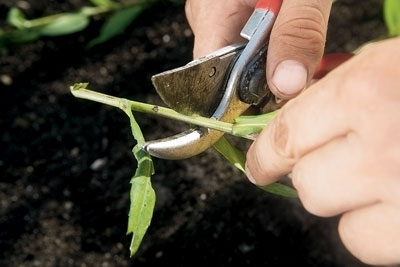 Each cutting should have 2 buds
Each cutting should have 2 buds
- Reproduction by seeds. The method is also called reckless:
- in October-November, just before the very cold weather, the seeds are sown in the soil;
- they should be tempered a little by sending them to the refrigerator for a week;
- just before planting, the seed is soaked in water at room temperature for 6 hours;
- for seeds harvested in the same season, these procedures can be skipped and go directly to sowing;
- so that the seeds are evenly covered with earth, they are lowered into small, pre-prepared grooves to a depth of no more than 0.5 cm and sprinkled with earth;
- after that, lightly watered with warm water;
- when the seedlings sprout and they have 2-3 first leaves, young plants need to be thinned out, keeping the distance between shoots 10-15 cm.
From purchased seeds, you can grow seedlings and only then plant the seedlings in the soil. How to do it:
 |
Step 1. Hardening the seeds |
- cover the seed mass with a napkin;
- leave on the vegetable rack for 7-8 days

Step 2. Soaking
leave the seeds in a weak solution of manganese for 10-12 hours

Step 3. Prepare containers with nutrient soil
- peat - 7 parts;
- cowshed - 1 part;
- sand - 1 part;
- leaf land - part 1
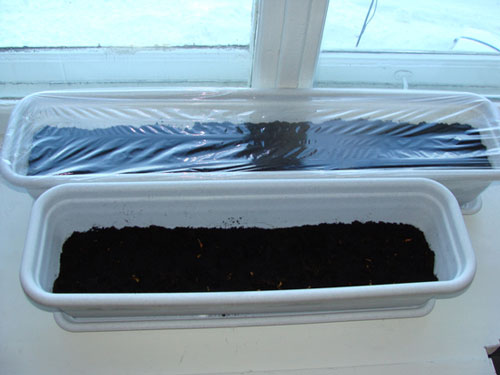
Step 4. Seed germination
- containers with seeds are left to germinate in a dry, warm place;
- the soil should not be allowed to dry out

Step 5. Additional lighting
So that the seeds do not suffer from a lack of lighting and grow strong and healthy, when the first leaves appear, install a phytolamp above the containers with seedlings (pictured)
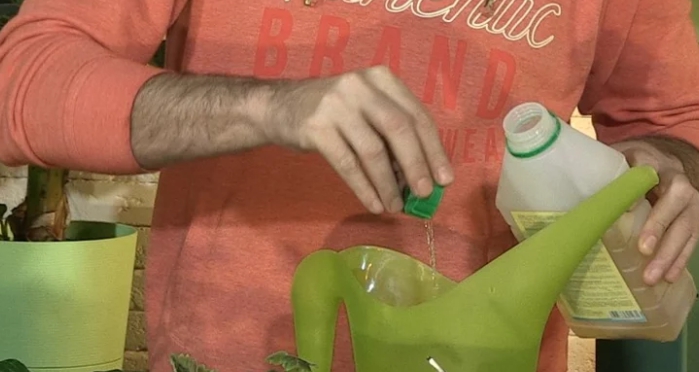
Step 6. Fertilization
- seedlings, while they are in the container, you need to feed 2 times;
- when a couple of leaves appear and 10 days before disembarking in the garden

Step 7. Hardening of seedlings
A week before planting in open soil, the seedlings need to be hardened by lowering the room temperature to +10 ° C
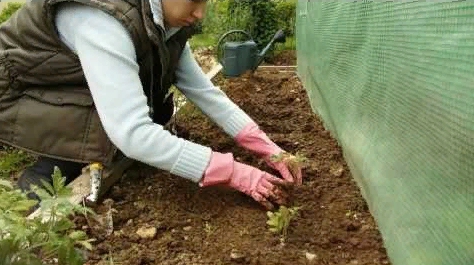
Step 8. Planting seedlings in the ground
For planting seedlings, you should choose a warm, slightly cloudy day:
- carefully remove the seedlings from the containers and transplant them into the ground;
- observe the distance between them - 20-30 cm;
- place in prepared holes, sprinkle with earth;
- press down slightly;
- to water
Video - how to propagate and when is it better to transplant the New Belgian aster.
Plant selection
Before talking about planting and caring for a flower in the open field, we suggest that you familiarize yourself with the most popular varieties of asters:
- Albus". White, low flower, blooming in June and July. It has short stems (maximum 20 cm), the leaves are quite dense.
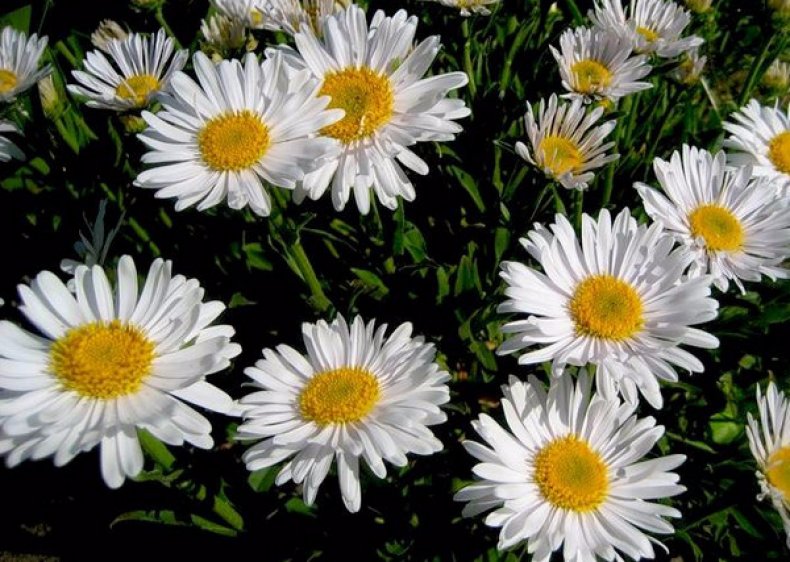 "Gloria". It stands out with blue flower rosettes, the inflorescences are small - their diameter is no more than 3 cm.
"Gloria". It stands out with blue flower rosettes, the inflorescences are small - their diameter is no more than 3 cm.
 "Goliath". The flowers have a delicate purple color, their diameter is 6 cm. Flowering falls in June.
"Goliath". The flowers have a delicate purple color, their diameter is 6 cm. Flowering falls in June.
 Rosea". The plant is characterized by pink inflorescences with a diameter of 4 cm.
Rosea". The plant is characterized by pink inflorescences with a diameter of 4 cm.
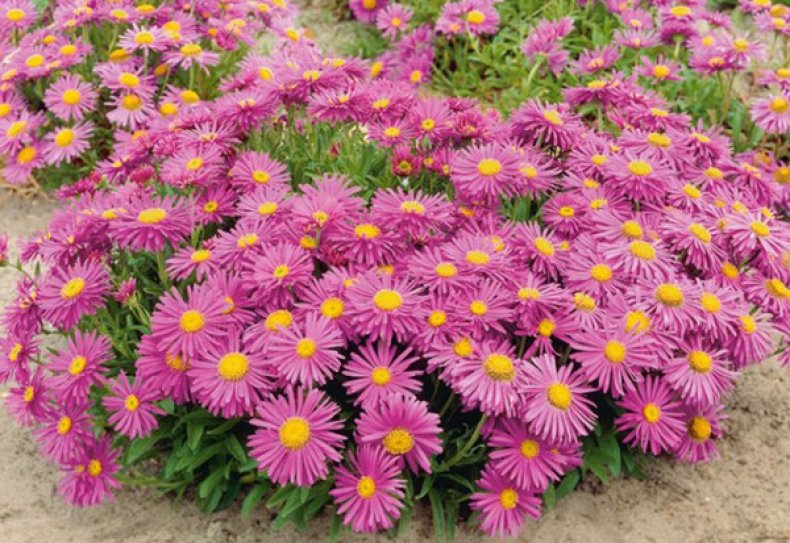 "Happy end". The variety has strong, straight stems, a large amount of foliage. Flowering begins in May and lasts until the end of the month.
"Happy end". The variety has strong, straight stems, a large amount of foliage. Flowering begins in May and lasts until the end of the month.
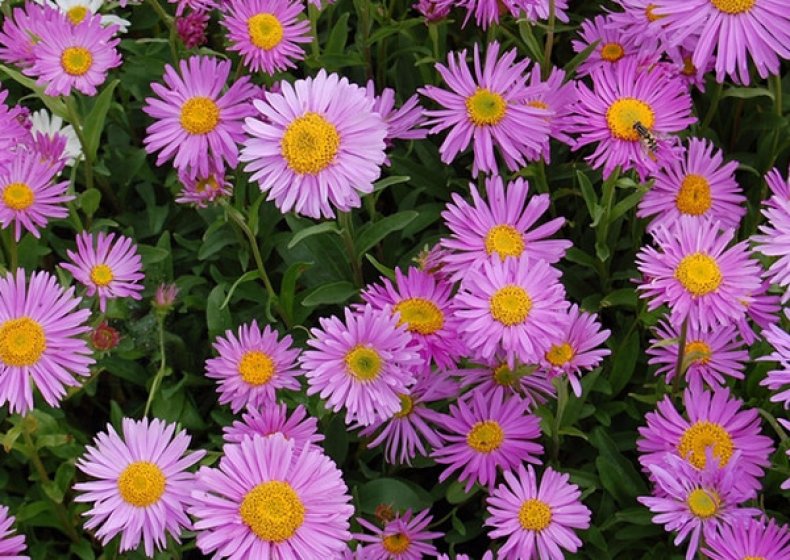 Dunkle Schöne". A flower with dark purple rosettes up to 3 cm in diameter.
Dunkle Schöne". A flower with dark purple rosettes up to 3 cm in diameter.
 "Ruber". A very bright representative of asters, the inflorescences are colored red-pink and have a diameter of up to 4 cm.
"Ruber". A very bright representative of asters, the inflorescences are colored red-pink and have a diameter of up to 4 cm.
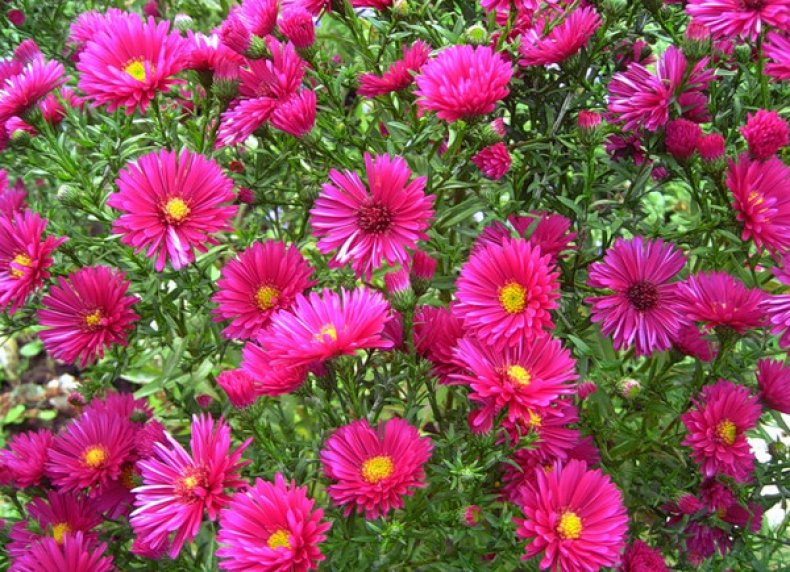
Did you know? Astra is a symbol of Tatarstan and is depicted on the emblem of the republic.The flower symbolizes eternal life and prosperity.
Superbus. The shade of the flower rosettes is lilac-blue, the diameter is 3.5 cm.
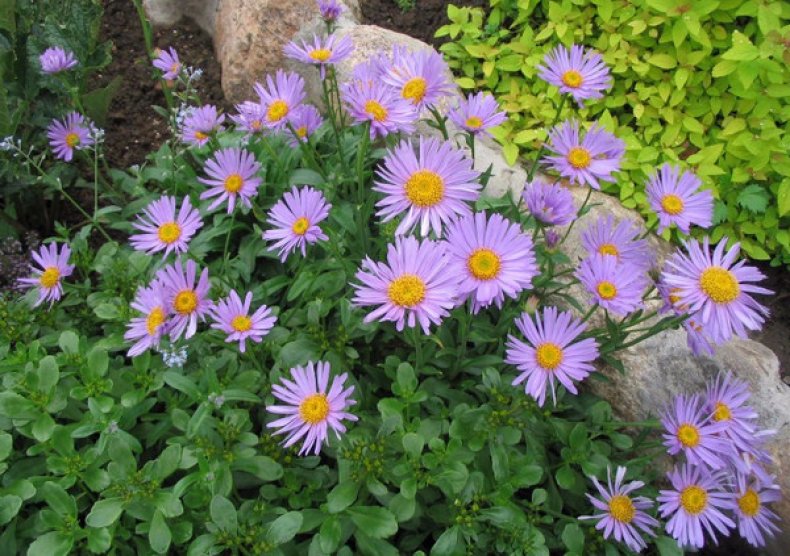
A huge variety of varieties allows you to choose plants that will fully meet your requirements and wishes.
Features of growing and care
An important characteristic of the Alpine aster is its unpretentiousness. But the culture is responsive to care, under favorable conditions it is possible to achieve long and massive flowering.
Cultivation and care are organized according to the rules of agricultural technology:
- Good lighting allows the shrub to grow and take on a three-dimensional appearance.
- Drainage of the soil improves survival.
- Abundant watering during the flowering season makes it more massive.
- Tall varieties require periodic feeding.
- With the arrival of autumn frosts, the shrub is cut to the root collar.
- In warm climates, the crop does not require winter shelter. In the northern regions, the bushes are covered with spruce branches or dry moss.
- In the spring, when pruning, the bush is eliminated from frozen stalks.
- It is advisable to sprinkle the exposed part of the root with soil or use it for transplantation by the method of division.
The place for planting is chosen on a hill, otherwise the roots get sick from the accumulated moisture. Dug up loams are suitable. The depleted soil is fed with organic fertilizers and lime.
Different techniques are suitable for reproduction.
Growing by seeds
Seeds are planted in the ground in early April, but be sure to cover the planting site with a film. The sprouts will hatch after a few weeks, then they can be transplanted to another location.
Another option is to plant it in a slightly frozen ground in the fall. In this case, special grooves are laid, which are then covered with soil. Shoots will hatch in the spring. The grown bushes are planted so as not to create excessive density.
The first weak bloom will occur in the first summer. It is advisable to cut the buds by the end of the season. Abundant flowering should be expected in the second summer. You only need to use fresh seeds, in this case the germination rate will be high.
Seedling method
This option involves the preliminary germination of seeds at home. Ready seedlings are transplanted in the open field in the spring. The rules of agricultural technology are as follows:
- They begin to prepare seedlings in late February - early March. You will need fertile soil, buy it in the store or prepare it by mixing garden soil with rotted manure. The container is picked up with drainage holes.
- The seeds can either be deepened a centimeter into the ground, or scattered over the surface and lightly sprinkled. Then gently water and place the container on the windowsill on the south side, where there is more light.
- When the first shoots appear, the container is transferred to a cooler room, up to 18 ° C.
- If individual cups are adapted for the container, a pick is not needed. Otherwise, it is produced when 3-4 full-fledged leaves appear.
- As it begins to warm, the seedlings begin to harden a little.
- Before planting, the soil on the site is disinfected with a hot solution of potassium permanganate.
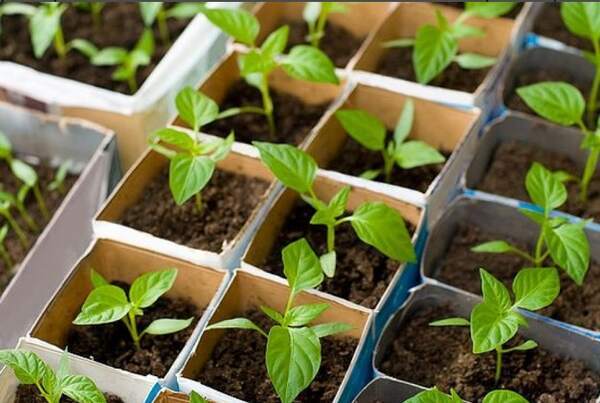 They begin to cook seedlings in late February - early March
They begin to cook seedlings in late February - early March
Propagation by cuttings
Suitable just for the case when it is desirable to preserve the varietal characteristics of the parent. The technique involves several simple actions:
- Choose healthy and strong young shoots. Cut so that 3 leaves remain on one cuttings. The cut site is treated with succinic acid or another stimulant.
- The cuttings are planted in fertile soil, which is prepared by mixing turf, sand and peat. The landing site is covered with a film.
- Water in moderation, excess and lack of moisture are equally harmful.
- The film is briefly removed daily for airing. Harvested completely at 4 weeks, when the cuttings are rooted.
The transplanting of mature bushes can be done in late August - early September.
Dividing the bush
The method is considered the simplest and most effective, it can be used all season. The division of the bush is done as follows:
- When the culture grows rapidly, part of the bush is separated (by the root) and transplanted to another place.
- Damaged and dry shoots are cut at the same time.
Flower care
Perennial alpine aster can grow in one place for up to 7 years, but 3-4 years are considered the optimal period. To extend the life span, it is recommended:
- water evenly with settled water;
- remove weeds and faded flowers of the crop;
- after watering and rain, loosen the ground, but shallowly, so as not to damage the roots;
- spud to strengthen the roots;
- feed during the period of growth and the appearance of buds;
- in spring, free the ground from snow faster, avoiding excess moisture.
Agricultural engineering issues
Question: I planted seedlings in open ground. The flower is already four years old. No blooming. I grew the seedlings myself from the seeds I collected in the park. Why isn't Astrantia blooming?
Answer: With proper agricultural technology, the culture begins to bloom in the fourth year. The amount of fertilizer may have been exceeded.
Question: I planted seeds of the Red Joyce variety, I collected seeds from a flower bed from a neighbor. However, Astrantia blooms with pale pink small flowers. A neighbor has bright red flowers on the bushes, how to explain the difference?
Answer: When breeding a crop with seeds that you collect yourself from a bush after flowering, deviations from the variety are possible. The plant is best propagated by dividing its root in the fall.
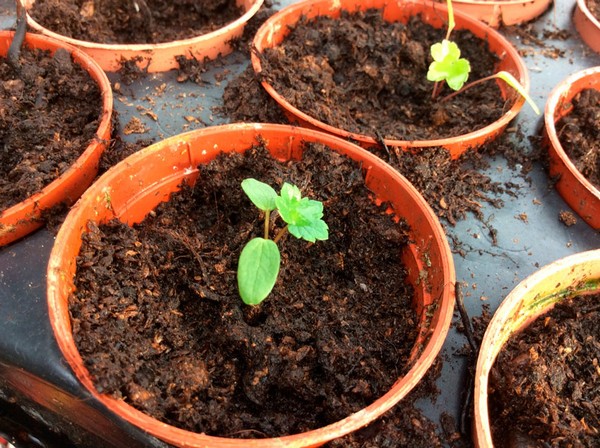
When propagated by seeds, differences from the mother plant are possible
Question: Didn't cover Astrantia during the winter. The frosts were below minus 35. Two bushes were frozen. How to cover the plant so that the stems and roots are not damaged?
Answer: In the fall, the plant is pruned, sprinkled on top with a layer of peat or compost. You need no more than 10 centimeters of dry layer. During the period of the first frost, they cover with cuttings of spruce branches.
Question: What distance should be left between seedlings of Astrantia bushes?
Answer: The plant is a large, tall bush. The distance should be at least 50 centimeters between the shoots.
Question: Tell me, is it necessary to cut the ground part of the plant for the period of the winter season? The culture is perennial, and when pruning, I remove the shoots in which flowering buds are laid.
Answer: In the fall, branches and shoots are removed. In the spring, the shoots will develop with renewed vigor, and the remaining parts of the matured stems will give new shoots.
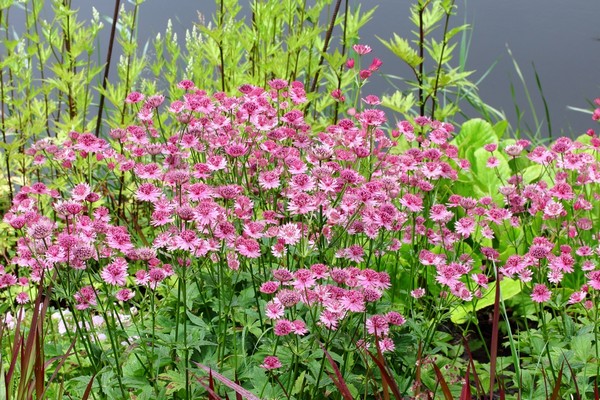
In the fall, you need to cut off branches and shoots.
Question: Tell me, is it possible to plant a large Astrantia in gardens next to asters and gladioli? I have not grown a flower before, can it harmoniously fit into the landscape?
Answer: Astrantia gets along with any “neighbor” and is unpretentious. It can grow in the shade and in open sunny areas. The soil should not be too wet. Depending on the variety, the stem height is determined, from 60 cm to 1 meter. Neighborhood will not harm the aster and gladiolus. Delicate flowers with delicate tones will only decorate the design of the territory.
Question: I brought the seeds of Astrantia from Europe, tried to get seedlings, but there were no shoots. Why?
Answer: Perhaps you brought low-quality seeds. The seeds of the plant usually sprout without problems.
Question: Explain, what size bush does an adult plant have? Is it tight? Should it be thinned out by pruning the branches?
Answer: The plant reaches a height of no more than one meter, but it all depends on the variety. The distance between adjacent bushes should be at least 50 centimeters, as the bush grows. It is not necessary to thin it out, the bush is not dense, compact. Some inflorescences are fading, while others are just getting ready. If the faded flowers are cut off, the flowering period can be increased.
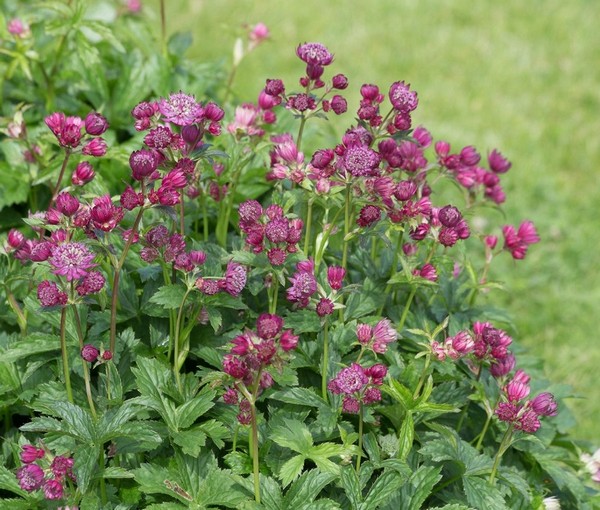
As a rule, the plant is not taller than one meter.
Question: Tell me, is it possible to plant Astrantia as a curb in the front garden? Is the flower too loose? How to deal with self-seeding?
Answer: Culture is great for the landscape as a living fence. If you cut off the flowering branches in a timely manner, you will get low borders with beautiful glossy leaves.Thus, you will get rid of self-seeding and provide yourself, all your friends and relatives with bouquets.
Question: I bought a branch of Astrantia today. What to do with him now? Should I plant it or put it in the cellar? When to sow seeds? Is it late in May?
Answer: It is necessary to plant seedlings in open ground in spring or autumn. You can plant it in open ground in May if the snow has already melted. If your scion is too small and growing in a container, it is best to wait until fall. Astrantia will grow and grow stronger. Seeds are planted in March in a nursery, container. Then, when the third leaf appears, they are transplanted to a permanent place of growth. The culture is unpretentious, well accepted, does not get sick during transplantation.
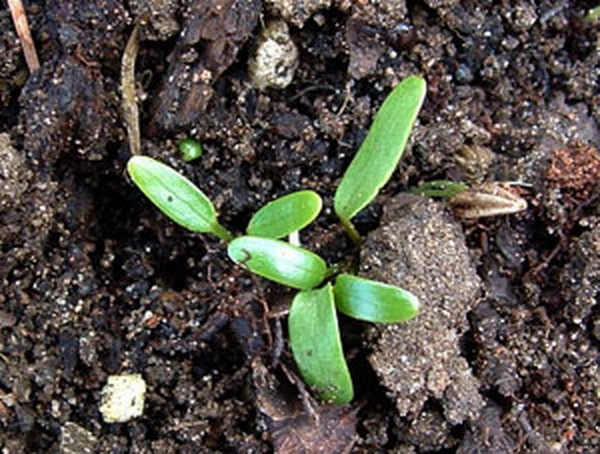
You can first grow the seedlings in a container, and then plant them in open ground.
Question: Please advise a variety with bright colors. I planted Astrantia with seeds, which I collected from a faded flower. But the flowers are pale, irregular.
Answer: Varietal crops are more expensive, but they are brighter and convey the properties and characteristics of the variety. Moulin Rouge is a great variety with vibrant flowers. Blooms for a long time.

